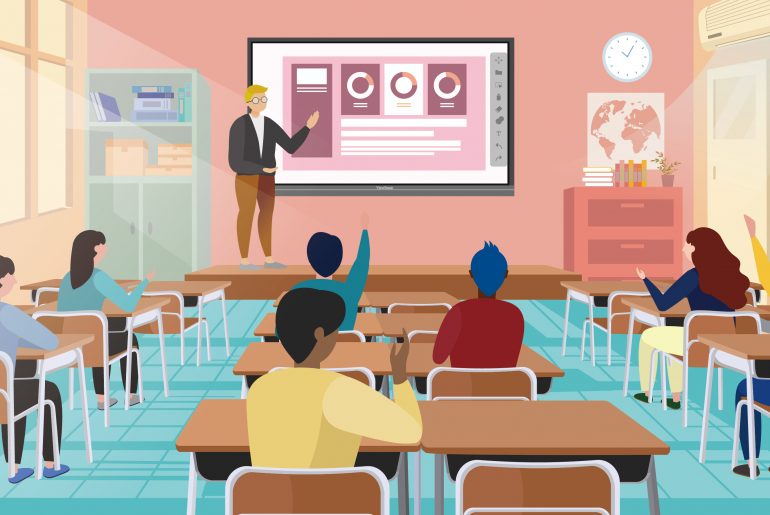This post is also available in: Français (French)
Quick – pop quiz time. What, besides a great teacher and excellent learning material, plays a fundamental role in student success? OK, it’s not really a fair question. There are too many other factors that come into play (maybe this should have been a multiple choice question). But, on your list of possibilities, did you include an optimized learning space? If not, you should have. What’s more, you don’t want to miss what lies ahead on the topic, either.
What is an Optimized Learning Space?
Basically, it’s a fancy term for maximizing the environmental factors inside a classroom. More specifically, it deals with how to improve:
- Lighting
- Acoustics
- Temperature and humidity

Lights, Please!
We all know about the need for good lighting. Reading in poor light is hard on the eyes and can lead to eyestrain. However, there’s more to correct lighting than just making sure students don’t read in dim light.
Research suggests that the color of light is of significance to student performance. A 2016 study out of South Korea looked at this phenomenon with Grade 4 students who were taking math exams. The results are a bit technical because of the use of the acronym “CCT,” which stands for “color-correlated temperature.” The main thing to remember about CCT is the color, not the actual heat, of the lights. Here are the details of the Korea Advanced Institute of Science and Technology’s research:
- The institute put 54 elementary students into two groups. One group was placed in a room with standard fluorescent lighting. The other sat in a room where the light could be adjusted from a “warm,” yellow-white hue of 3500 K (Kelvin) to a “neutral” color of 5000 K, up to 6500 K, with a “cool,” bluish-white hue close to natural daylight.
- Researchers found the “cool” light of 6500 K produced the best scores on the math tests.
- Through interviews, it was found that, for break-time activities, the “warm” 3500 K lighting was the most comfortable for students.
It makes sense, then, for schools to invest in the best type of lighting, depending on the activity. A fuller scientific explanation of the research is available here:
Sounds About Right
If lighting impacts on academic success, it make sense that sound does, too. Apart from sounds coming from outside the classroom, those inside the class and school building can interfere with learning. These include:
- Loud air-conditioners or fans
- Talkative students (in the class and in the hallways)
- Noise from heaters or other machines
Such distractions are truly bothersome. This especially true for those with hearing difficulties, behavioral issues, learning disabilities, or attention problems. Needless to say, it’s not fun for teachers, either.
Students disrupting class by talking can be told to quiet down, and noisy machines can be turned off temporarily. But what about noise the teacher has no control over? Here is where optimized learning spaces help. To improve classroom acoustics, use these tips:
- Put up curtains on the windows
- Place rugs on the floor
- Hang decorative rugs or other soft material on walls
- Replace old ceiling tiling with special acoustic tiles.
These will all “soften” sounds by helping to absorb them rather than letting them bounce all around.

Hot, Cold, Dry, Wet Enough For You?
Now we come to elements often overlooked regarding optimizing learning space – temperature and humidity. As it turns out, there is a “Goldilocks zone” for this. For humidity, it’s between 30 to 50%. That is, not too sticky yet not too dry. Anything outside this range may cause students to feel uncomfortable, sap their energy, and make them distracted. Not only that, but also humid classrooms can breed bacteria, fungus, and mold. In contrast, some diseases, such as measles and the flu, spread faster in low-humidity environments.
Certainly, temperatures in classrooms need to be controlled to avoid discomfort as well. Members of the Science Research Club at an Oregon school won a Special Achievement Award for showing that students performed best on aptitude tests when the average temperature was 81 degrees Fahrenheit (27 C). Check out more about this here: https://www.buildings.com/news/industry-news/articleid/3005/title/temperature-impacts-student-performance

A Little Goes a Long Way
As you can see, there are many ways to optimize learning space. Opting for lighting closer to daylight, putting down rugs, placing curtains on windows, and better controlling temperature and humidity all help student performance. Take a look at your learning environment. What improvements are needed?
-Brian Foden




